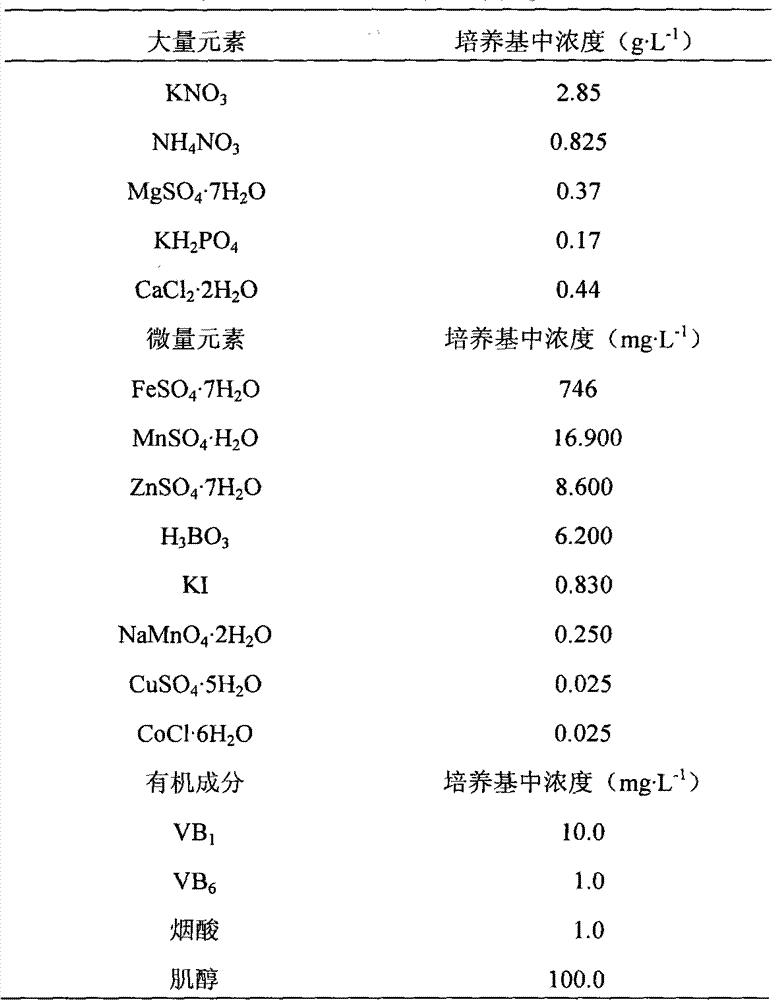Method for culturing directly differentiated tissues of cotton true leaf and special culture medium
A technology of culture medium and germination medium, which is applied in the field of plant tissue culture, can solve the problems of low regeneration frequency, lack of difficulty, poor leaf and stem segments, etc., and achieve the effect of easy material selection and shortening the culture period
- Summary
- Abstract
- Description
- Claims
- Application Information
AI Technical Summary
Problems solved by technology
Method used
Image
Examples
Embodiment 1
[0031] Embodiment 1, acquisition of cotton regenerated seedlings and statistical observation thereof
[0032] 1. Preparation of embryogenic callus
[0033] 1) Pretreatment of explants
[0034] The true leaves of field cotton plants were taken as explants. After taking back the cotton leaves, prepare 8 high-temperature sterilized (121°C, 14min) petri dishes, add appropriate amount of sterilized water (121°C, 14min) to No. 1, 6, 7, and 8 petri dishes, and 2, 3, 4 add HgCl with a mass percentage concentration of 0.1% in the petri dish 2 solution.
[0035] Among them, there are 3 varieties of cotton, which are:
[0036] China Cotton Research Institute 24, sold by the Technology Trading Company of the Cotton Research Institute of the Chinese Academy of Agricultural Sciences;
[0037] Jihe 321, sold by the Technology Trading Company of the Cotton Research Institute of the Chinese Academy of Agricultural Sciences;
[0038]China Cotton Research Institute 27, sold by the Technolo...
Embodiment 2
[0058] Embodiment 2, the acquisition of cotton regenerated seedlings and statistical observation thereof
[0059] The difference between this embodiment and embodiment 1 lies in the following three points, and all the other steps are identical:
[0060] 1. The raw material used is only China Cotton Research Institute 24, which is cultivated by the early-maturing breeding research group of the Cotton Research Institute of the Chinese Academy of Agricultural Sciences and sold by the Science and Technology Trading Company of the Cotton Research Institute of the Chinese Academy of Agricultural Sciences.
[0061] 2. EC1 medium: Add kinetin (KT), 6-BA, 2,4-D, IAA, glucose, Gel rite on the basis of MSB1 basic medium; the final concentration of KT is 0.005mg / L , The final concentration of 6-BA is 0.005mg / L, the final concentration of 2,4-D is 0.0001mg / L, the final concentration of IAA is 0.001mg / L, the final concentration of glucose is 25g / L, the final concentration of Gel rite The c...
Embodiment 3
[0066] Embodiment 3, the acquisition of cotton regenerated seedlings and statistical observation thereof
[0067] The difference between this embodiment and embodiment 1 lies in the following three points, and all the other steps are identical:
[0068] 1. The raw material used is only China Cotton Research Institute 24, which is cultivated by the early-maturing breeding research group of the Cotton Research Institute of the Chinese Academy of Agricultural Sciences and sold by the Science and Technology Trading Company of the Cotton Research Institute of the Chinese Academy of Agricultural Sciences. ;
[0069] 2. EC1 medium: Add kinetin (KT), 6-BA, 2,4-D, IAA, glucose, Gel rite on the basis of MSB1 basic culture medium; among them, the final concentration of KT is 0.15mg / L , The final concentration of 6-BA is 0.15mg / L, the final concentration of 2,4-D is 0.001mg / L, the final concentration of IAA is 0.02mg / L, the final concentration of glucose is 35g / L, the final concentration...
PUM
 Login to View More
Login to View More Abstract
Description
Claims
Application Information
 Login to View More
Login to View More - R&D
- Intellectual Property
- Life Sciences
- Materials
- Tech Scout
- Unparalleled Data Quality
- Higher Quality Content
- 60% Fewer Hallucinations
Browse by: Latest US Patents, China's latest patents, Technical Efficacy Thesaurus, Application Domain, Technology Topic, Popular Technical Reports.
© 2025 PatSnap. All rights reserved.Legal|Privacy policy|Modern Slavery Act Transparency Statement|Sitemap|About US| Contact US: help@patsnap.com



